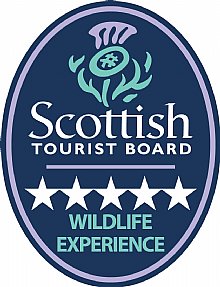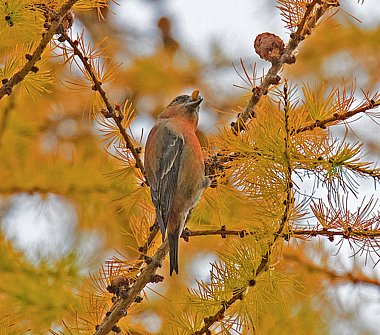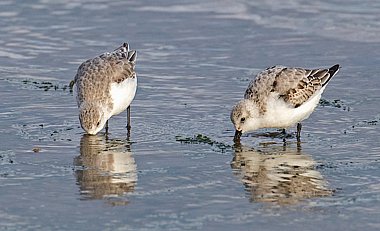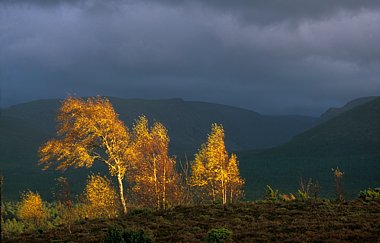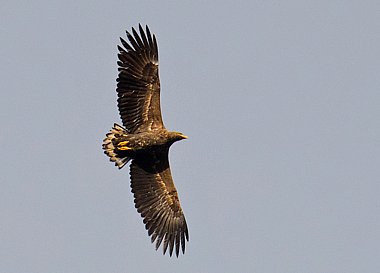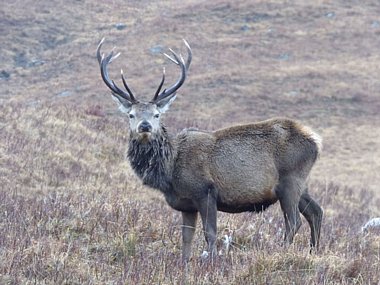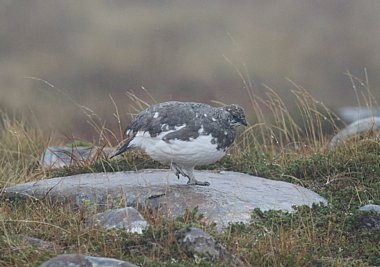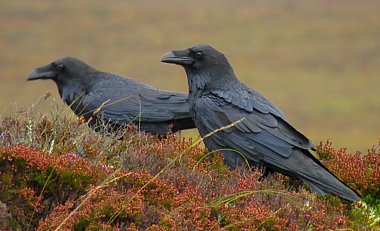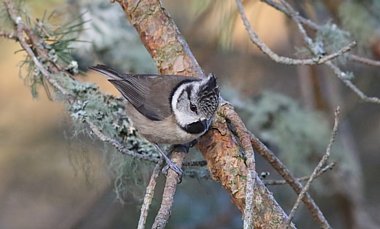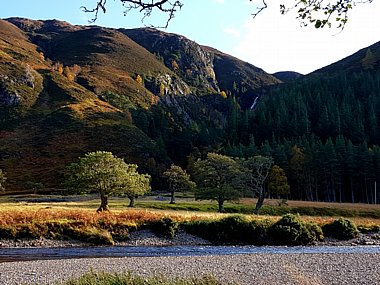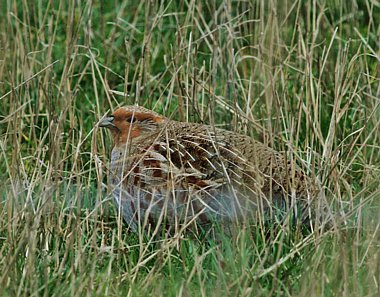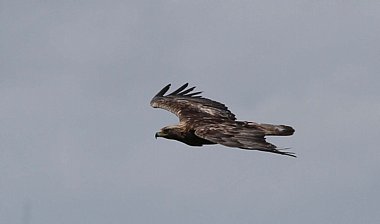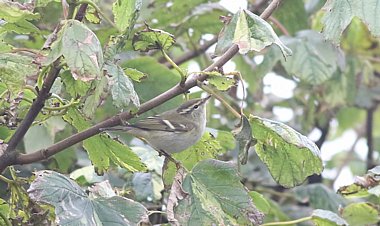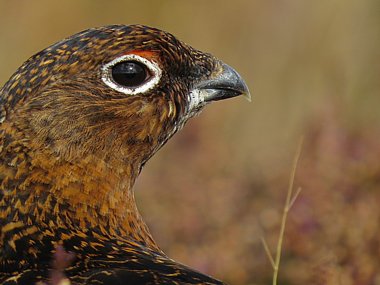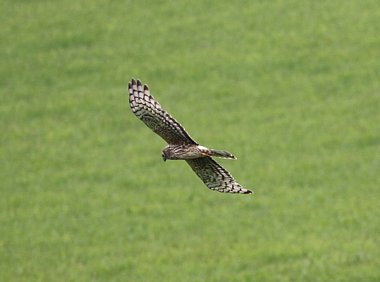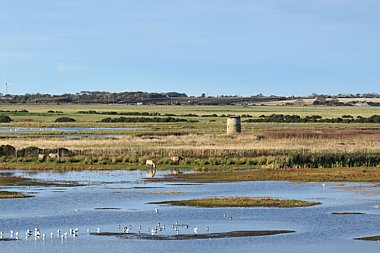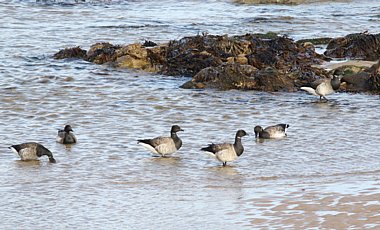NEW! Highlands and the Far North in Autumn
Great local birding and exciting migration in Caithness and north-east Highlands.
| Destination | |
|---|---|
| Focus | |
| 2025 Dates | |
| Duration | 8 Days |
| Guides | |
| 2025 Price | £1695 pp No single supplement. Deposit £300 |
| 2026 Dates | |
| Duration | 8 Days |
| 2026 Price | £1695 pp No single supplement. Deposit £300 |
On this new tour we combine local specialities at a time when numbers are at their highest, with rarely visited Caithness and the nearby Sutherland coasts at the peak of autumn migration.
Locally we search for Black and Red Grouse on the moors and Ptarmigan in the hills. Crested Tit and (a variety of) Crossbills are likely in the woods too, and can be especially abundant at this time following a good breeding season or cone crop. One of the best periods of the birding year for raptors, we have good chances of seeing Golden and White-tailed Eagle, Goshawk, Red Kite, Peregrine and a late Osprey, plus Hen Harrier, Merlin and possibly Short-eared Owl during our time in Caithness.
On a three-day, two-night adventure to Caithness we explore a number of habitats and lesser-known birding sites. Autumn migration will be in full flow, and depending on the prevailing winds can bring large numbers of birds and/or rarities from either direction. The far north can be a great place to observe incoming geese, passing seabirds while waders, terns and a wide range of passerines will be on the move south from Scandinavia. It is an exciting time of year for birders, and this is an exciting place to go birdwatching!
KEY MOMENTS at our Friday round-up - which will be yours?
- Golden Eagle and other raptors at quiet, lesser-known locations.
- A passerine 'fall', with bushes full of thrushes, chats, warblers and finches in a Caithness valley!
- The first winter arrivals with geese in the fields, and divers, grebes and sea-duck offshore.
- Highland specialities such as Crested Tit, Black Grouse and Ptarmigan at a time when local populations are at their peak.
Day 1: Saturday – Arrival
Arrival, welcome, dinner and briefing. Don’t forget our courtesy collection service from Aviemore.
Day 2: Sunday – Local Forest and Moorland birding
The Abernethy Forest is a great place to begin, and strolling through the old Caledonian pines we look for Crested Tit among autumn tit flocks. Scottish Crossbill are also found here, though with both Common and Parrot Crossbill also present, separation of these three species can pose a real identification challenge! Red Squirrel and Roe Deer are both likely from forest trails. Capercaillie also occur, though increasingly scarce and we no longer actively look for them. Any sightings should be seen as incidental. In local birch woods we watch out for Siskin, Lesser Redpoll and Bullfinch, and from the riverside hope to encounter Dipper, Grey Wagtail, Goldeneye and Goosander. In the afternoon we move into open moorland, scanning for Golden and White-tailed Eagle, Red Kite, Peregrine and Kestrel. Red Grouse may also be seen, and the sound of rutting Red Deer stags echoing through the hills is an enchanting experience!
Day 3: Monday – Migrant hunting on the East Highland Coast
Heading north for Sutherland and Caithness, we have numerous birding options whatever the weather! Flexibility is an important factor on any migration-based tour, and if the winds are from the east and favourable for passerines making landfall, we may visit the Tarbat Peninsula. Positioned perfectly to ‘catch’ southbound migrants, a walk around the scrubby cover and plantations may produce warblers, flycatchers, thrushes, Redstart, Whinchat, Wheatear or perhaps something scarcer. With a reputation for attracting eastern rarities, Yellow-browed, Greenish, Icterine and Barred Warbler, Red-breasted Flycatcher, Red-backed Shrike and Common Rosefinch have featured in previous autumns- will we get lucky?! The inland fields support flocks of passing geese, Golden Plover, Skylark, pipits and wagtails, and there are many excellent coastal sites for migrant waders and wildfowl to investigate on our way north.
Day 4: Tuesday - Exploring Caithness
We spend the full day exploring at leisure the coastal bays and beaches, freshwater lochs, farmland fields, isolated headlands and quiet, lesser-known valleys for migrant birds. In the lee of the Orkney Isles, Caithness is an unjustly under-watched region of Scotland, but a growing realisation of the birding treasures it may yield has led more effort from exploratory birders. With cover sparse, anywhere can attract birds, and among the eastern rarities of the last few years alone have been Red-flanked Bluetail, Dusky, Radde’s and Greenish Warbler. Around the headlands, Twite, Wheatear, Skylark and pipits are likely, and we look out for Ring Ouzel among migrant flocks of Fieldfare, Song Thrush and Redwing in the fields.
On beaches and at wetland sites, it is a good time of year to find a passing Little Stint, Curlew or Wood Sandpiper among commoner waders, while rarer Nearctic species have included Pectoral Sandpiper, Wilson’s Phalarope, Greater and Lesser Yellowlegs. Caithness is an important region for wintering birds, with Whooper Swan, Pink-footed and Greenland White-fronted Goose, Great Northern and Black-throated Diver and Slavonian Grebe among the species arriving at this time. Freshwater supports large numbers of wildfowl, and with Otter, cetaceans and seals possible too, we will certainly enjoy our day exploring the far north!
Day 5: Wednesday - North Coast and return to Nethy Bridge
Taking stock of the birds we have seen (and more so, the ones we might like to look for...), we make our birding plans around travelling south. The harbours and fishing ports on the north coast may well be worth a look for any early returning Iceland or Glaucous Gull, and if it is a ‘sea-watching kind of day’ we can try Strathy Point. Strong winds might make for challenging birding, but they can also bring sea birds closer to land and possibilities include Sooty and Manx Shearwater, Sabine’s and Little Gull, Grey Phalarope and all four skuas – namely Great, Pomarine, Arctic and Long-tailed. Out on exposed headlands, Snow and Lapland Bunting often join the Skylark and pipit flocks and there are some nice, sheltered spots on the north Sutherland coast to look for passerines too. Options inland include the Flow Country, a huge floating peat bog attractive to raptors such as White-tailed Eagle, Hen Harrier and Short-eared Owl. Working our way south through the day, we investigate easy to reach coastal sites before arriving back at the Mountview Hotel in time for dinner.
Day 6: Thursday – The Crown Estates and Royal Deeside
Travelling eastwards from Nethy Bridge, a visit to a Black Grouse lek is a great start to our day. Continuing to Royal Deeside, and into the mountains we have a chance of Ptarmigan, Red Grouse and Mountain Hare perhaps without any, or very little walking. Later we scan from viewpoints for raptors which might include Golden and White-tailed Eagle, Hen Harrier, Goshawk, Peregrine, Osprey and Red Kite. On the Crown Estates at Glenlivet, we have exclusive access to secluded spots with further chances of raptors while overhead passage birds often include geese, thrushes and finches in this truly wild area of the Cairngorms National Park.
Day 7: Friday – Moray Coast or Black Isle
A round up day, your guide selecting an area of the coast where new species are most likely. Offshore, wintering seaduck numbers will be building and we have excellent chances of Common and Velvet Scoter, Scaup and Long-tailed Duck, plus divers and grebes. On the tidal estuaries and rocky coasts, concentrations of waders may include the first Purple Sandpiper to return, plus Bar and Black-tailed Godwit, Sanderling, Dunlin, Turnstone, Knot and plenty more. Sandwich, Common and Arctic Tern should also still be around, while roosting gull flocks at this time of year can sometimes contain Mediterranean Gull – still a rare bird in Scotland! Venturing inland will help boost our days bird tally with Tree Sparrow, Linnet, Yellowhammer, Corn Bunting and Grey Partridge among the possibilities in farmland.
Day 8: Saturday – Departure
Breakfast and departure. Don’t forget our courtesy return service to Aviemore.
This holiday can be combined with:
MAINLAND SCOTLAND
The 'Outer Limits' Adventure
SCOTTISH ISLANDS
North Ronaldsay and Orkney for birders in Autumn, Outer Hebrides for birders in Autumn
Please note: all itineraries are given as a guide only. Actual holiday content may vary according to the judgement of your guide, and elements beyond our control (eg weather).
What's included in your holiday price
- Five nights comfortable accommodation at The Mountview Hotel, VisitScotland rated 3 Star. All rooms are en-suite, with TV and hospitality tray. There is no single supplement, and guests are never expected to share. Single guests may be upgraded to double room accommodation at no extra charge. Two nights in a comfortable hotel in Caithness, all rooms en-suite.
- Full Scottish breakfast, a substantial packed lunch, and a delicious dinner.
- Six full days wildlife watching.
- Guidance from a professional Group Leader.
- All transport by comfortable minibus.
- A checklist specifically prepared for your holiday to record your sightings and notes.
- Courtesy bus service to and from transport in Aviemore.
What's not included in your holiday price
- Insurance, drinks and other items of a personal nature.
More holiday information
Accommodation at Mountview Hotel can be seen here. All accommodation is en-suite unless otherwise advised before your booking is confirmed. 2 nights away in en-suite accommodation in Caithness.
Food There is a choice of evening meal, and vegetarian, vegan and other diets are welcome. Breakfast may be chosen from a full Scottish menu. You don't need flasks for hot drinks.
Walking will be light, although the optional mountain walking for Ptarmigan is strenuous. Guests can opt out of this excursion.
Weather Expect a wide variation in weather conditions. Blazing sunshine and rain are equally likely, and you will probably experience a bit of everything. Bring waterproofs, walking boots or shoes and warm clothing. Hat and gloves are essential for the mountain and exposed coastal locations.
Biting insects are not expected.
Group size maximum 7 clients per guide.
Optics Telescopes will be useful, and you should bring binoculars. We have a limited number of top quality Swarovski binoculars, which you may borrow at no charge (subject to availability). A camera would be useful too!
Other birdwatching holidays in Highlands
- Raptors and Grouse
- Autumn in the Highlands with 'Easy Walking'
- Autumn Migration in the Highlands
- Birders' Blasts in Autumn!
- Birders' Blasts in Winter!
- Birding the Highlands in May
- Birding the North Coast 500
- Butterflies, Dragons and Birds
- Cairngorms and East Sutherland
- High Season Across the Highlands
- Highland Autumn Birding
- Highland Autumn Explorer
- Highland Mammals and More!
- Highland Migration by land and sea
- Highland Wildlife in early summer
- Highland Wildlife in High Summer
- Highland Winter Birding
- Highlands & Ardnamurchan
- Highlands & East Coast Birding
- Highlands & Orkney
- Highlands and Corncrake
- Highlands and Skye in Autumn
- Highlands and Skye in spring
- Highlands and the Outer Hebrides
- Highlands and the West Coast
- Highlands and Wester Ross
- Hogmanay Birding Extravaganza
- New Year Birdlist Booster
- NEW! A Scottish Celebration - Wildlife and Whisky
- NEW! Highlands and East Neuk of Fife
- NEW! Highlands and Grampian Explorer
- NEW! Highlands and the Small Isles
- NEW! Highlights of the Highlands - Wildlife and Culture
- NEW! Strathspey Walking and Wildlife
- NEW! Walking and Wildlife
- North West Scotland Explorer
- North-east Scotland Explorer
- Scottish Wildlife in Late Autumn
- Scottish Winter Specialities
- Short Breaks - Scottish Birding in Autumn
- Spring into Scotland including Mull
- Spring Migration in the Highlands
- The 'Outer Limits' Adventure
Why choose Heatherlea for your Scottish birding holiday?
Heatherlea is THE place for top quality birding holidays in Scotland, chosen by more and more birders each year. Stay in our own three star Small Hotel, and enjoy first-rate birding with Scotland’s best guiding team. Relax and enjoy yourself, as we do all the planning! Above all, we make it our business to show key wildlife to you. Our fully inclusive guided holidays concentrate on the real experience, and we take time to ensure that each of our guests enjoys everything we do.
- We have been organising birding and wildlife holidays for 30 seasons, and have a highly experienced and capable office team. We also offer a telephone and email service outside normal office hours.
- Our ‘Mainland Scotland’ holidays based at Mountview Hotel have a maximum ratio of 7 clients per guide, putting the emphasis on personal service, and helping you get the best possible experience.
- We are a small company, run BY birders FOR birders. Come and see!
- Heatherlea are Mainland Scotland’s FIRST ‘5-Star Wildlife Experience!’ This is the highest available grading, classified as ‘exceptional’ by visitScotland.
- There is no single supplement. Single guests are never expected or invited to share.
- Our holidays often include things which others might invite you to pay yourself, for instance loan of Swarovski binoculars, packed lunch and tips to hotels.
- We offer a courtesy transfer between our Hotel and Aviemore rail/bus links on Saturdays.
- Heatherlea hold full Tour Operator Insurance for your added protection.
- Heatherlea is a limited company, registered in Scotland. We are also registered to pay VAT, which is included in your holiday price as quoted on this page.
- Once your holiday is confirmed in writing by us, we promise not to surcharge the price for any reason.
Enjoy an excellent birding and wildlife holiday with Heatherlea.
Mainland Scotland’s FIRST ‘5-Star Wildlife Experience!’
'Exceptional'
Visit Scotland
Trip Reports
Coming Soon

